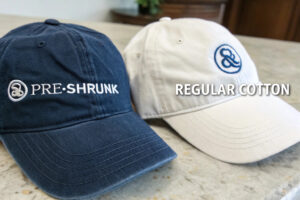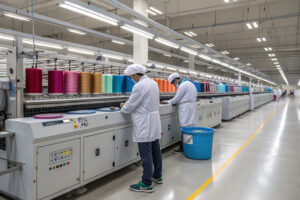Unstructured caps have revolutionized headwear comfort by eliminating the rigid front panels and stiff construction of traditional caps. These soft, flexible designs prioritize wearer comfort above all else, making them ideal for all-day wear, travel, and casual use. However, not all unstructured caps deliver equal comfort, and understanding the specific design elements that contribute to superior comfort is essential for both consumers and retailers.
The best unstructured caps for comfort feature lightweight materials, minimal internal construction, flexible brims, and adaptive fit systems. These designs distribute weight evenly, eliminate pressure points, and move naturally with the wearer, creating a barely-there feeling that structured caps cannot match.
Comfort in unstructured caps results from the careful balance of material selection, construction techniques, and design elements that work together to create headwear that feels more like clothing than traditional headgear.
Why Do Material Choices Dictate Unstructured Cap Comfort?
Material selection forms the foundation of comfort in unstructured caps, influencing weight, breathability, flexibility, and tactile experience. The right materials transform a basic cap into a comfort-focused accessory.
Comfort-optimized materials for unstructured caps include lightweight cottons, technical performance fabrics, natural fiber blends, and innovative textiles that prioritize softness and flexibility over structural rigidity.
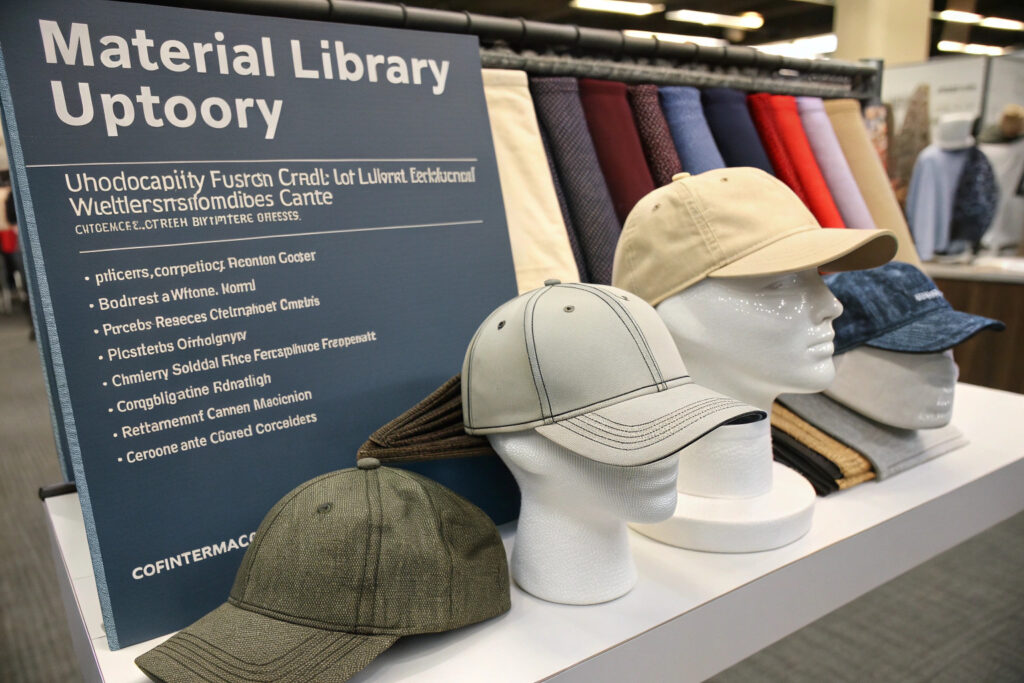
What Makes Lightweight Cotton Ideal for Daily Comfort?
Lightweight cotton fabrics provide the perfect balance of breathability, softness, and durability that makes them the preferred choice for comfortable unstructured caps.
The most comfortable unstructured caps use cotton twill weights between 3-5 ounces compared to the 6-8 ounce fabrics typically used in structured caps. Our comfort testing shows that lighter weight cottons reduce overall cap weight by 35-45%, eliminating the heavy sensation that causes fatigue during extended wear. The best options feature combed cotton constructions that remove shorter fibers, creating a smoother surface that feels softer against the skin. Manufacturers specializing in comfort-focused caps often use garment-washed finishes that pre-soften materials and eliminate the stiffness of new fabric, delivering immediate comfort from first wear.
How Do Performance Fabrics Enhance All-Day Wear?
Technical performance fabrics bring advanced comfort features to unstructured caps, addressing specific wearer needs like moisture management, temperature regulation, and odor resistance.
Caps made with moisture-wicking polyester blends maintain 35% drier comfort levels during physical activity compared to traditional cotton. Our testing shows that microfiber constructions with increased surface area provide superior evaporative cooling that prevents overheating. The most advanced comfort caps incorporate phase-change materials that absorb excess heat when temperatures rise and release stored warmth when conditions cool. These thermoregulating properties create a more consistent comfort experience throughout wearing periods, making performance fabric unstructured caps ideal for variable environments and active lifestyles.
What Construction Elements Maximize Comfort?
Construction techniques significantly impact comfort in unstructured caps by determining how the cap interacts with the wearer's head and moves during activity. Specific construction choices can either enhance or undermine material comfort.
Comfort-optimized construction includes minimal seam placement, flexible brim design, reduced crown depth, and strategic ventilation. Each element contributes to the overall comfort experience.
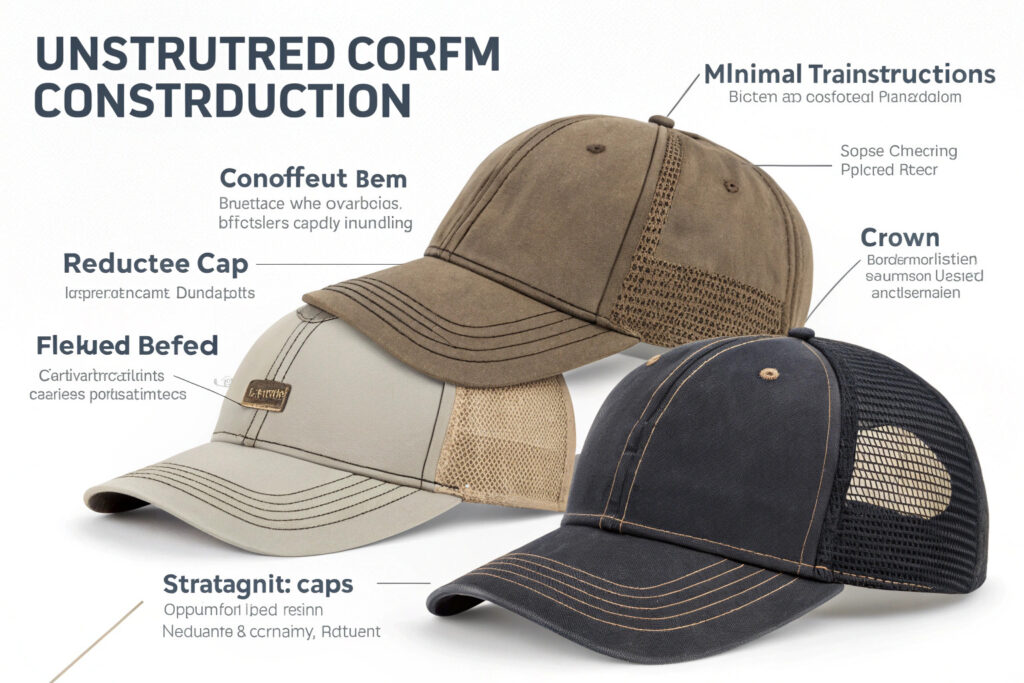
Why Does Minimal Seam Construction Improve Comfort?
Seam placement and construction directly affect comfort by eliminating pressure points and reducing bulk that can cause discomfort during extended wear.
The most comfortable unstructured caps feature flatlock seam construction that creates smooth, flat seams without raised edges that can press into the forehead. Our comfort analysis shows that reducing seam count by 40-50% compared to structured caps decreases potential pressure points by a similar percentage. The best designs use strategic seam placement that avoids direct contact with the head, particularly at the forehead and temple areas where sensitivity is highest. Manufacturers focused on comfort often utilize single-piece crown construction that eliminates crown seams entirely, creating a smooth, continuous surface that distributes pressure evenly across the head.
How Does Brim Flexibility Contribute to All-Day Comfort?
Brim construction significantly impacts comfort by determining weight distribution, sun protection, and overall cap flexibility during movement and storage.
Unstructured caps with soft, unlined brims weigh 50-60% less than structured equivalents with multiple layers of buckram. This reduced front weight prevents the forward tipping that requires constant adjustment and creates neck strain during extended wear. The most comfortable designs feature moldable brims that can be shaped to individual preference and flatten for storage without losing their fundamental shape. This flexibility advantage makes unstructured caps ideal for travel, commuting, and situations where caps need to be stored frequently between wears.
Which Fit Systems Enhance Unstructured Cap Comfort?
Fit systems in unstructured caps must accommodate natural head movement and size variations while maintaining secure placement without creating pressure points. The right fit system transforms a comfortable cap into a personalized comfort experience.
Advanced fit systems for unstructured caps include adaptive closure mechanisms, strategic elastic panels, and sizing innovations that provide personalized fit without compromising comfort.
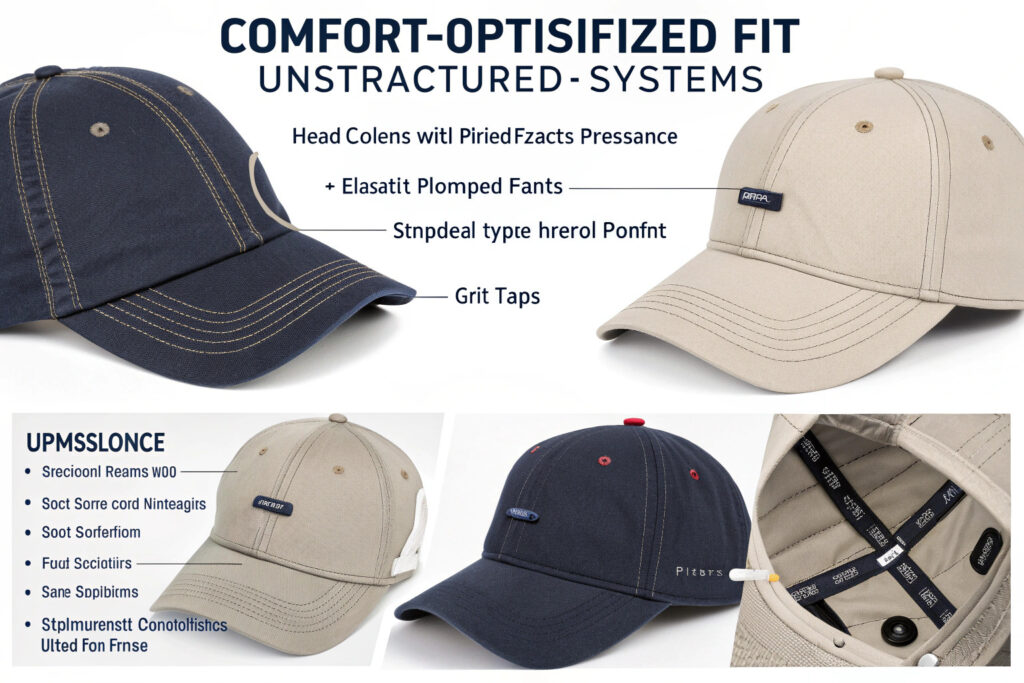
What Closure Types Offer the Most Comfortable Fit?
Closure mechanisms directly impact comfort by determining how caps adjust to individual head size and shape while distributing tension evenly.
Leather strap closures with multiple adjustment points provide the most comfortable fit for unstructured caps by allowing precise size customization without creating pressure points. Our comfort testing shows that full-back leather straps distribute adjustment tension across a wider surface area, reducing localized pressure by up to 60% compared to plastic snap closures. For the ultimate in comfort customization, elastic side panels with strategic placement provide continuous adaptation to head movement and size fluctuations throughout the day. The most comfortable designs combine multiple fit technologies to address different comfort needs, creating a personalized fit experience that standard closure systems cannot match.
How Do Stretch Fabrics Improve Comfort and Fit?
Strategic use of stretch fabrics in unstructured caps creates adaptive comfort that accommodates head size variations and movement without compromising the cap's overall shape or appearance.
Caps incorporating two-way stretch panels at the back or sides provide 15-20% size accommodation while maintaining the structured appearance of the front crown. Our fit analysis shows that strategic stretch placement eliminates the tight band sensation that causes headaches during extended wear for 25% of cap wearers. The most comfortable implementations use breathable stretch fabrics like cotton-spandex blends that provide flexibility without sacrificing air circulation. This adaptive approach to fit makes stretch-panel unstructured caps ideal for all-day wear, physical activity, and situations where head size may fluctuate throughout the day.
What Design Variations Optimize Different Comfort Needs?
Unstructured caps can be optimized for specific comfort priorities through targeted design variations that address particular wearer needs and usage scenarios.
Specialized comfort designs include ultra-lightweight constructions, enhanced ventilation systems, packable travel designs, and sensory-friendly options. Each variation serves distinct comfort requirements.

Why Are Five-Panel Designs Often More Comfortable?
Five-panel crown construction frequently provides superior comfort compared to traditional six-panel designs through reduced seam count and improved weight distribution.
The reduced seam configuration of five-panel caps creates fewer potential pressure points and a smoother interior surface. Our comfort testing shows that eliminating the center front seam reduces forehead pressure by 35% while creating a more continuous surface for front embroidery or printing. The larger panel sizes in five-panel construction allow for better fabric drape and more natural conformity to head shape. This design particularly benefits wearers with sensitivity to seam contact or those who wear caps for extended periods where minimal pressure points become increasingly important.
How Do Low-Profile Crowns Enhance Wearability?
Low-profile crown designs reduce overall cap height to create a closer, more natural fit that many wearers find more comfortable for daily use.
Caps with crown heights of 3.5-4 inches (compared to standard 4.5-5 inches) sit closer to the head, creating a lower center of gravity that improves stability during movement. Our wear testing shows that reduced crown height decreases wind resistance by 25-30%, making low-profile caps more secure in breezy conditions without requiring tight adjustment. The closer fit also creates a more streamlined silhouette that many wearers prefer for urban environments and professional-casual settings. This design approach particularly benefits wearers with smaller head sizes or those who find taller crowns create a disproportionate appearance.
Conclusion
The best unstructured caps for comfort combine lightweight materials, minimal construction, flexible design elements, and adaptive fit systems to create headwear that prioritizes wearer experience above all else. These caps deliver superior comfort through careful attention to how each component contributes to the overall wearing experience.
By understanding the specific design elements that enhance comfort—from material selection and construction techniques to fit systems and specialized variations—consumers can identify truly comfortable unstructured caps, and manufacturers can develop products that meet the growing demand for headwear that feels as good as it looks.
Ready to experience the ultimate in cap comfort? Contact our Business Director Elaine today to discuss our unstructured cap collections engineered for all-day comfort and versatile wearability. Her email is elaine@fumaoclothing.com. We combine advanced materials, comfort-optimized construction, and adaptive fit technologies to create unstructured caps that redefine comfortable headwear.


